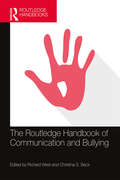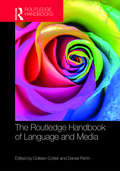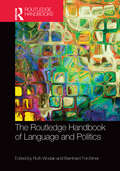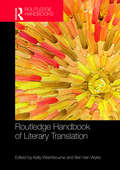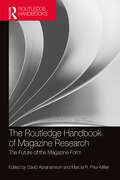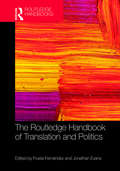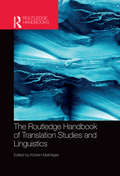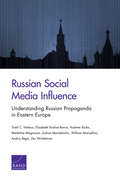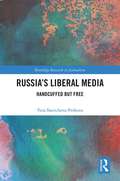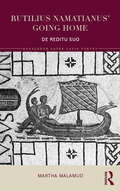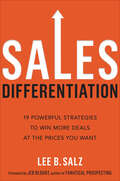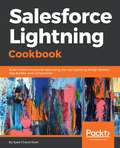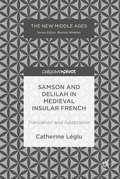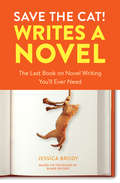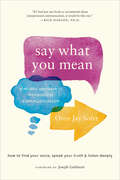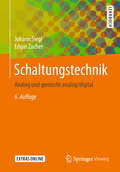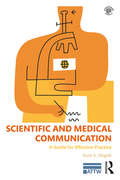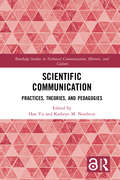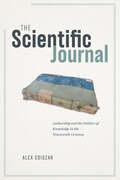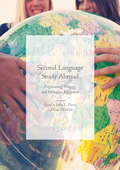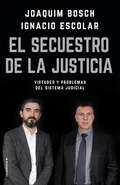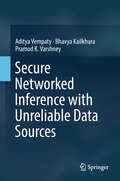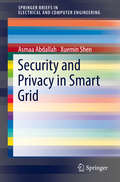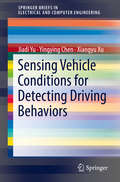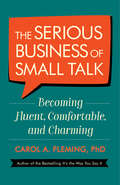- Table View
- List View
The Routledge Handbook of Communication and Bullying
by Richard West Christina S. BeckThe Routledge Handbook of Communication and Bullying provides an essential and unique analysis of bullying and anti-bullying efforts from a communication-based perspective. Drawing on communication theory and compelling empirical research, this volume offers valuable international perspectives of this pervasive concern, examined within varied contexts. In addition to providing exemplary data-based scholarship, the Handbook is comprised of first-hand accounts of those who have been bullied, adding an integral pragmatic and complementary dimension to the topic. This anthology serves as a useful resource for educators, administrators, managers, and other stakeholders who are challenged with this difficult social issue. Responding to the various charges emanating from the National Communication Association’s (NCA) Anti-Bullying Project, this collection constitutes a valuable foundation from which to draw as conversations about bullying continue around the globe.
The Routledge Handbook of Language and Media
by Colleen Cotter Daniel PerrinThe Routledge Handbook of Language and Media provides an accessible and comprehensive overview of state-of-the-art research in media linguistics. This handbook analyzes both language theory and practice, demonstrating the vital role of this research in understanding language use in society. With over thirty chapters contributed by leading academics from around the world, this handbook: addresses issues of language use, form, structure, ideology, practice, and culture in the context of both traditional and new communication media; investigates mediated language use in public spheres, organizations, and personal communication, including newspaper journalism, broadcasting, and social media; examines the interplay of language and media from both linguistic and media perspectives, discussing auditory and visual media and graphic modes, as well as language and gender, multilingualism, and language change; analyzes the advantages and shortcomings of current approaches within media linguistics research and outlines avenues for future research. The Routledge Handbook of Language and Media is a must-have survey of this key field, and is essential reading for those interested in media linguistics.
The Routledge Handbook of Language and Politics (Routledge Handbooks in Linguistics)
by Ruth Wodak and Bernhard ForchtnerThe Routledge Handbook of Language and Politics provides a comprehensive overview of this important and dynamic area of study and research. Language is indispensable to initiating, justifying, legitimatising and coordinating action as well as negotiating conflict and, as such, is intrinsically linked to the area of politics. With 45 chapters written by leading scholars from around the world, this Handbook covers the following key areas: Overviews of the most influential theoretical approaches, including Bourdieu, Foucault, Habermas and Marx; Methodological approaches to language and politics, covering – among others – content analysis, conversation analysis, multimodal analysis and narrative analysis; Genres of political action from speech-making and policy to national anthems and billboards; Cutting-edge case studies about hot-topic socio-political phenomena, such as ageing, social class, gendered politics and populism. The Routledge Handbook of Language and Politics is a vibrant survey of this key field and is essential reading for advanced students and researchers studying language and politics.
The Routledge Handbook of Literary Translation (Routledge Handbooks in Translation and Interpreting Studies)
by Kelly Washbourne Ben Van WykeThe Routledge Handbook of Literary Translation provides an accessible, diverse and extensive overview of literary translation today. This next-generation volume brings together principles, case studies, precepts, histories and process knowledge from practitioners in sixteen different countries. Divided into four parts, the book covers many of literary translation’s most pressing concerns today, from teaching, to theorising, to translation techniques, to new tools and resources. Featuring genre studies, in which graphic novels, crime fiction, and ethnopoetry have pride of place alongside classics and sacred texts, The Routledge Handbook of Literary Translation represents a vital resource for students and researchers of both translation studies and comparative literature.
The Routledge Handbook of Magazine Research: The Future of the Magazine Form (Routledge Media and Cultural Studies Handbooks)
by David Abrahamson and Marcia R. Prior-MillerScholarly engagement with the magazine form has, in the last two decades, produced a substantial amount of valuable research. Authored by leading academic authorities in the study of magazines, the chapters in The Routledge Handbook of Magazine Research not only create an architecture to organize and archive the developing field of magazine research, but also suggest new avenues of future investigation. Each of 33 chapters surveys the last 20 years of scholarship in its subject area, identifying the major research themes, theoretical developments and interpretive breakthroughs. Exploration of the digital challenges and opportunities which currently face the magazine world are woven throughout, offering readers a deeper understanding of the magazine form, as well as of the sociocultural realities it both mirrors and influences. The book includes six sections: -Methodologies and structures presents theories and models for magazine research in an evolving, global context. -Magazine publishing: the people and the work introduces the roles and practices of those involved in the editorial and business sides of magazine publishing. -Magazines as textual communication surveys the field of contemporary magazines across a range of theoretical perspectives, subjects, genre and format questions. -Magazines as visual communication explores cover design, photography, illustrations and interactivity. -Pedagogical and curricular perspectives offers insights on undergraduate and graduate teaching topics in magazine research. -The future of the magazine form speculates on the changing nature of magazine research via its environmental effects, audience, and transforming platforms.
The Routledge Handbook of Translation and Politics (Routledge Handbooks in Translation and Interpreting Studies)
by Jonathan Evans Fruela FernandezThe Routledge Handbook of Translation and Politics presents the first comprehensive, state of the art overview of the multiple ways in which ‘politics’ and ‘translation’ interact. Divided into four sections with thirty-three chapters written by a roster of international scholars, this handbook covers the translation of political ideas, the effects of political structures on translation and interpreting, the politics of translation and an array of case studies that range from the Classical Mediterranean to contemporary China. Considering established topics such as censorship, gender, translation under fascism, translators and interpreters at war, as well as emerging topics such as translation and development, the politics of localization, translation and interpreting in democratic movements, and the politics of translating popular music, the handbook offers a global and interdisciplinary introduction to the intersections between translation and interpreting studies and politics. With a substantial introduction and extensive bibliographies, this handbook is an indispensable resource for students and researchers of translation theory, politics and related areas.
The Routledge Handbook of Translation Studies and Linguistics (Routledge Handbooks in Translation and Interpreting Studies)
by Kirsten MalmkjærThe Routledge Handbook of Translation Studies and Linguistics explores the interrelationships between translation studies and linguistics in six sections of state-of-the-art chapters, written by leading specialists from around the world. The first part begins by addressing the relationships between translation studies and linguistics as major topics of study in themselves before focusing, in individual chapters, on the relationships between translation on the one hand and semantics, semiotics and the sound system of language on the other. Part II explores the nature of meaning and the ways in which meaning can be shared in text pairs that are related to each other as first-written texts and their translations, while Part III focuses on the relationships between translation and interpreting and the written and spoken word. Part IV considers the users of language and situations involving more than one language and Part V addresses technological tools that can assist language users. Finally, Part VI presents chapters on the links between areas of applied linguistics and translation and interpreting. With an introduction by the editor and an extensive bibliography, this handbook is an indispensable resource for advanced students of translation studies, interpreting studies and applied linguistics.
Russian Social Media Influence: Understanding Russian Propaganda in Eastern Europe
by Todd C. Helmus Andrew Radin Zev Winkelman William Marcellino Andriy Bega Elizabeth Bodine-Baron Madeline Magnuson Joshua MendelsohnRussia employs a sophisticated social media campaign against former Soviet states that includes news tweets, nonattributed comments on web pages, troll and bot social media accounts, and fake hashtag and Twitter campaigns. Nowhere is this threat more tangible than in Ukraine. Researchers analyzed social media data and conducted interviews with regional and security experts to understand the critical ingredients to countering this campaign.
Russia's Liberal Media: Handcuffed but Free (Routledge Research in Journalism)
by Vera Slavtcheva-PetkovaThis book examines the challenges and pressures liberal journalists face in Putin's Russia. It presents the findings of an in-depth qualitative study, which included ethnographic observations of editorial meetings during the conflict in Ukraine. It also provides a theoretical framework for evaluating the Russian media system and a historical overview of the development of liberal media in the country. The book focuses on some of Russia’s most influential liberal national news outlets: "the deadliest" newspaper Novaya Gazeta, "Russia’s last independent radio station" Radio Echo of Moscow (Ekho Moskvy) and US Congress-funded Radio Free Europe/Radio Liberty. The fieldwork included ethnographic observations of editorial meetings, long interviews with editors and journalists as well as documentary analysis. The monograph makes theoretical contributions to three main areas: 1. Media systems and terms of reference. 2. Journalism: cultures, role conceptions, and relationship with power, culture and society. 3. Mediatisation of conflict and nationhood.
Rutilius Namatianus' Going Home: De Reditu Suo (Routledge Later Latin Poetry)
by Martha MalamudMartha Malamud provides the only scholarly English translation of De Reditu Suo with significant notes and commentary that explore historical, literary, cultural, and mythical references, as well as commenting on literary allusions, the structure, diction, and style of the poem, and textual issues. De Reditu Suo provides fascinating insights into travel and communications networks in the rapidly changing, fragmented world of the fifth century. A substantial introductory essay explores Rutilius’ place in several intellectual and literary traditions, as the poem is a sophisticated piece of literature that both draws on the rich tradition of classical Latin poetry and reflects the distinctive formal features of late antique poetry. The poem also conveys the thoughts of a man passionately devoted to Rome and its cultural heritage, enmeshed in the tumultuous political and social upheaval of his day, caught between his hopes for Rome’s restoration and his fear of its disintegration. With line-for-line translation from the Latin and a scholarly introduction, extensive notes, and comprehensive bibliography, Martha Malamud makes this important text accessible and relevant for students and scholars in Classics, Comparative Literature, Religious Studies, Medieval Studies, and Ancient History, as well as independent readers with an interest in the literature of the period.
Sales Differentiation: 19 Powerful Strategies to Win More Deals at the Prices You Want
by Lee B. Salz"If we don't drop our price, we will lose the deal." That's the desperate cry from salespeople as they try to win deals in competitive marketplaces. While the easy answer is to lower the price, the company sacrifices margin--oftentimes unnecessarily.To win deals at the prices you want,the strategy needed is differentiation. Most executives think marketing is the sole source of differentiation. But what about the sales function of the company? This commonly neglected differentiation opportunity provides a multitude of ways to stand out from the competition. This groundbreaking book teaches you how to develop those strategies.In Sales Differentiation, sales management strategist, Lee B. Salz presents nineteen easy-to-implement concepts to help salespeople win deals while protecting margins. These concepts apply to any salesperson in any industry and are based on the foundation that "how you sell, not just what you sell, differentiates you." The strategies are presented in easy-to-understand stories and can quickly be put into practice. Divided into two sections, the "what you sell" chapters help salespeople:Recognize that the expression "we are the best" causes differentiation to backfire.Avoid the introspective question that frustrates salespeople and ask the right question to fire them up.Understand what their true differentiators are and how to effectively position them with buyers.Find differentiators in every nook and cranny of the company using the six components of the "Sales Differentiation Universe."Create strategies to position differentiators so buyers see value in them.The "how you sell" section teaches salespeople how to provide meaningful value to buyers and differentiate themselves in every stage of the sales process. This section helps salespeople:Develop strategies to engage buyers and turn buyer objections into sales differentiation opportunities.Shape buyer decision criteria around differentiators.Turn a commoditized Request for Proposal (RFP) process into a differentiation opportunity. Use a buyer request for references as a way to stand out from the competition.Leverage the irrefutable, most powerful differentiator...themselves.Whether you've been selling for twenty years or are new to sales, the tools you learn in Sales Differentiation will help you knock-out the competition, build profitable new relationships, and win deals at the prices you want.
Salesforce Lightning Cookbook: Build modern enterprise apps using the new Lightning Design System, App Builder, and Components
by Syed Chand ShahOver 25 recipes to help you design and test informative applications on the Salesforce Lightning platformKey FeaturesLearn Salesforce Lightning concepts from scratch.Build scalable enterprise apps with Salesforce design guidelines and the CSS frameworkUse Visualforce to build custom user interfaces for mobile and web appsBook DescriptionThe new Lightning Experience combines three major components—Lightning Design System, Lightning App Builder, and Lightning Components—to enable anyone to quickly and easily create beautiful, modern enterprise apps. If you wish to meet the challenges that Lightning throws at you head-on, then look no further because this practical book will be your faithful companion and ensure that you make best use of the Lightning platform.The book starts by walking you through the three major Lightning Components and helps you enable and configure a Lightning solution. You will explore the art of working with standard components and build a basic layout for the application. Then, you will add more advanced components using the Lightning Framework. Finally, you will also build and migrate reports and dashboards to make your app look more professional. Towards the end of the book, you’ll make use of Design System to work with Salesforce data and lay out the entire page with the components that you’ve built, before integrating Visualforce in your application.What you will learnEnable and configure a Lightning solutionCreate standard Lightning solutions and build a basic page layoutAdd custom components to your Lightning pagesBuild and migrate reports and dashboardsIntegrate Lightning pages with Visualforce to enhance performanceAdd stunning custom designs and styling with Lightning Design SystemWho this book is forThis book is ideal for Salesforce developers, admins, sales consultants, and sales managers who are comfortable with using Lightning features to build basic apps. Experience with JavaScript, CSS, and HTML would be an advantage but not compulsory.
Samson and Delilah in Medieval Insular French: Translation and Adaptation (The New Middle Ages)
by Catherine LégluSamson and Delilah in Medieval Insular French investigates several different adaptations of the story of Samson that enabled it to move from a strictly religious sphere into vernacular and secular artworks. Catherine Léglu explores the narrative’s translation into French in medieval England, examining the multiple versions of the Samson narrative via its many adaptations into verse, prose, visual art and musical. Utilizing a multidisciplinary approach, this text draws together examples from several genres and media, focusing on the importance of book learning to secular works. In analysing this Biblical narrative, Léglu reveals the importance of the Samson and Delilah story as a point of entry into a fuller understanding of medieval translations and adaptations of the Bible.
Save the Cat! Writes a Novel: The Last Book On Novel Writing You'll Ever Need (Save the Cat!)
by Jessica BrodyThe first novel-writing guide from the best-selling Save the Cat! story-structure series, which reveals the 15 essential plot points needed to make any novel a success.Novelist Jessica Brody presents a comprehensive story-structure guide for novelists that applies the famed Save the Cat! screenwriting methodology to the world of novel writing. Revealing the 15 "beats" (plot points) that comprise a successful story--from the opening image to the finale--this book lays out the Ten Story Genres (Monster in the House; Whydunit; Dude with a Problem) alongside quirky, original insights (Save the Cat; Shard of Glass) to help novelists craft a plot that will captivate--and a novel that will sell.
Say What You Mean: A Mindful Approach to Nonviolent Communication
by Oren Jay SoferFind your voice, speak your truth, listen deeply—a guide to more meaningful and mindful conversations.We spend so much of our lives talking to each other, but how much are we simply running on automatic—relying on old habits and hoping for the best? Are we able to truly hear others and speak our mind in a clear and kind way, without needing to get defensive or go on the attack? In this groundbreaking synthesis of mindfulness, somatics, and Nonviolent Communication, Oren Jay Sofer offers simple yet powerful practices to develop healthy, effective, and satisfying ways of communicating. The techniques in Say What You Mean will help you to: · Feel confident during conversation · Stay focused on what really matters in an interaction · Listen for the authentic concerns behind what others say · Reduce anxiety before and during difficult conversations · Find nourishment in day-to-day interactions
Schaltungstechnik: Entwicklungsmethodik, Funktionsschaltungen, Funktionsprimitive Von Schaltkreisen (Springer-Lehrbuch)
by Johann Siegl Edgar ZocherDas Lehrbuch bietet eine gründliche und systematische Einführung in die Entwicklungs- und Analysemethodik analoger und gemischt analog/digitaler Schaltungen. Leser lernen, wie Schaltungen erfolgreich entwickelt werden können. Wesentlich hierfür ist die funktionsorientierte Vorgehensweise, die durch eine Einführung in die Abschätzanalyse und in rechnergestützte Entwurfsverfahren unterstützt wird. Mit vielen anschaulichen Beispielen und Übungsaufgaben. Zusätzlich kann ein virtuelles Labor mit 300 Experimenten und weiteren Aufgaben genutzt werden.
Scientific and Medical Communication: A Guide for Effective Practice (ATTW Series in Technical and Professional Communication)
by Scott A. MogullScientific and Medical Communication: A Guide for Effective Practice prepares readers to effectively communicate in professional scientific communities. The material in this book is firmly grounded in more than 500 published research findings and editorials by scientific writers, authors, and journal editors. Thus, this text provides the broadest and most comprehensive analysis of scientific writing. In addition, carefully selected and thoroughly annotated examples from the scientific and medical literature demonstrate the recommendations covered in the text. These real-world examples were carefully selected so that the scientific content can be understood by those without a detailed background in any particular scientific or medical field—thus clearly illustrating the content organization and writing style. This text will prepare individuals to write and edit scientific manuscripts, conference abstracts, posters, and press releases according to journal and professional standards. Readers will also learn to conduct effective searches of the scientific and medical literature, as well as proper citation practices.
Scientific Communication: Practices, Theories, and Pedagogies (Routledge Studies in Technical Communication, Rhetoric, and Culture)
by Han Yu Kathryn M. NorthcutThis book addresses the roles and challenges of people who communicate science, who work with scientists, and who teach STEM majors how to write. In terms of practice and theory, chapters address themes encountered by scientists and communicators, including ethical challenges, visual displays, and communication with publics, as well as changed and changing contexts and genres. The pedagogy section covers topics important to instructors’ everyday teaching as well as longer-term curricular development. Chapters address delivery of rhetorically informed instruction, communication from experts to the publics, writing assessment, online teaching, and communication-intensive pedagogies and curricula.
The Scientific Journal: Authorship and the Politics of Knowledge in the Nineteenth Century
by Alex CsiszarNot since the printing press has a media object been as celebrated for its role in the advancement of knowledge as the scientific journal. From open communication to peer review, the scientific journal has long been central both to the identity of academic scientists and to the public legitimacy of scientific knowledge. But that was not always the case. At the dawn of the nineteenth century, academies and societies dominated elite study of the natural world. Journals were a relatively marginal feature of this world, and sometimes even an object of outright suspicion. The Scientific Journal tells the story of how that changed. Alex Csiszar takes readers deep into nineteenth-century London and Paris, where savants struggled to reshape scientific life in the light of rapidly changing political mores and the growing importance of the press in public life. The scientific journal did not arise as a natural solution to the problem of communicating scientific discoveries. Rather, as Csiszar shows, its dominance was a hard-won compromise born of political exigencies, shifting epistemic values, intellectual property debates, and the demands of commerce. Many of the tensions and problems that plague scholarly publishing today are rooted in these tangled beginnings. As we seek to make sense of our own moment of intense experimentation in publishing platforms, peer review, and information curation, Csiszar argues powerfully that a better understanding of the journal’s past will be crucial to imagining future forms for the expression and organization of knowledge.
Second Language Study Abroad: Programming, Pedagogy, And Participant Engagement
by John L. Plews Kim MisfeldtThis edited volume explores studying second languages abroad by critically and constructively reviewing established programming, providing theoretical and research-informed support for pedagogical and curriculum interventions, and analysing participant experiences. Over 12 chapters the contributors examine key issues including teaching approaches, learning activities, and relationships in the target language and culture. This book is most distinct in its attempt to promote diversity in approaches and experiences while drawing the common thread of learner- and learning-centredness through each chapter. The contributing authors represent a wide range of academies and discuss study abroad programs and participants in diverse cultural and geographic regions. The book’s international scope will acquaint educators and researchers with a broad variety of practices, stimulate comparison across contexts, and promote innovation.
El secuestro de la justicia: Virtudes y problemas del sistema judicial
by Ignacio Escolar Joaquim Bosch Grau¿Está la justicia española secuestrada por los políticos? Joaquim Bosch (ex portavoz de Juezas y Jueces para la Democracia) e Ignacio Escolar (director de eldiario.es) han unido fuerzas para escribir un libro necesario, incisivo y pedagógico sobre la Justicia. El sistema judicial está en crisis. Así lo denuncia esta reflexión crítica sobre un deterioro que afecta profundamente a nuestra democracia. En una escalada sin precedentes, las injerencias políticas son muy visibles, se concentran en la cúpula judicial y son especialmente peligrosas en los casos de corrupción. Por otro lado, la ciudadanía percibe que las leyes no siempre son iguales para todos. Las maniobras que tratan de capturar las instituciones judiciales están relacionadas con un fenómeno más amplio: los intentos de secuestro de la Justicia como valor. Por eso los autores también estudian: las injusticias que padecen las víctimas de violencia machista, y los que padecen abusos bancarios; los problemas en la aplicación de la prisión provisional o los excesos en los límites de la política de penas de privación de libertad; el drama de los refugiados y la criminalización de los inmigrantes; la falta de reparación de las víctimas del franquismo; la actuación de la justicia en el conflicto catalán; y los crecientes recortes de libertades. Pero El secuestro de la Justicia es también una defensa de la magnífica base del sistema judicial, esa inmensa mayoría de magistrados que no se ha dejado contaminar. Como los que llevaron los abusos bancarios a la jurisdicción europea y vencieron. O los que, sin medios suficientes, investigan la corrupción y ponen contra las cuerdas a políticos y a empresarios. La crítica ha dicho...«Relato pedagógico sobre separación de poderes.»EFE «Un texto ensayístico, pero escrito con estilo periodístico, orientado a plantear una larga serie de reflexiones y dudas sobre el llamado tercer poder.»Juan Bolea, El Periódico de Aragón «Un libro fundamentalpara entender nuestro país. No solo recomendable, sino imprescindible.»Carlos Ávila, Andamios (y la vida sigue)
Secure Networked Inference with Unreliable Data Sources
by Pramod K. Varshney Bhavya Kailkhura Aditya VempatyThe book presents theory and algorithms for secure networked inference in the presence of Byzantines. It derives fundamental limits of networked inference in the presence of Byzantine data and designs robust strategies to ensure reliable performance for several practical network architectures. In particular, it addresses inference (or learning) processes such as detection, estimation or classification, and parallel, hierarchical, and fully decentralized (peer-to-peer) system architectures. Furthermore, it discusses a number of new directions and heuristics to tackle the problem of design complexity in these practical network architectures for inference.
Security and Privacy in Smart Grid (SpringerBriefs in Electrical and Computer Engineering)
by Asmaa Abdallah Xuemin ShenThis SpringerBrief addresses the main security concerns for smart grid, e.g., the privacy of electricity consumers, the exchanged messages integrity and confidentiality, the authenticity of participated parties, and the false data injection attacks. Moreover, the authors demonstrate in detail the various proposed techniques to secure the smart grid’s different communication networks and preserve the privacy of the involved. Over many years, power grid has generated electricity from central generators and distributed it in one direction from the generation stations to end-users; also, information is one directional so that the grid’s control center doesn’t get enough information about customers’ requirements and consequently can’t prevent electricity losses. So, the electricity grid is merged with information and communication technology to form smart grid. The main target of this incorporation is to connect different parties of power grid to exchange information about grid conditions and customers’ requirements, and consequently, improve the reliability and efficiency of electricity generation and distribution. That upgrade of the power grid exposes it to the cyber security threats that the communication networks suffer from, such as malicious attacks to forge the electricity consumption readings or price, extract personal information for residential consumers, such as daily habits and life style, or attack some grid’s resources and equipment availability using denial-of-service attacks. Also, novel threats are introduced in smart grid due to the power grid nature, such as false data injection attack, in which the adversary compromises several measurement units and injects false information about the grid conditions that mislead the grid’s control center to make wrong decisions for the grid and consequently impact on its stability and efficiency.
Sensing Vehicle Conditions for Detecting Driving Behaviors (Springerbriefs In Electrical And Computer Engineering)
by Jiadi Yu Yingying Chen Xiangyu XuThis SpringerBrief begins by introducing the concept of smartphone sensing and summarizing the main tasks of applying smartphone sensing in vehicles. Chapter 2 describes the vehicle dynamics sensing model that exploits the raw data of motion sensors (i.e., accelerometer and gyroscope) to give the dynamic of vehicles, including stopping, turning, changing lanes, driving on uneven road, etc. Chapter 3 detects the abnormal driving behaviors based on sensing vehicle dynamics. Specifically, this brief proposes a machine learning-based fine-grained abnormal driving behavior detection and identification system, D3, to perform real-time high-accurate abnormal driving behaviors monitoring using the built-in motion sensors in smartphones.As more vehicles taking part in the transportation system in recent years, driving or taking vehicles have become an inseparable part of our daily life. However, increasing vehicles on the roads bring more traffic issues including crashes and congestions, which make it necessary to sense vehicle dynamics and detect driving behaviors for drivers. For example, sensing lane information of vehicles in real time can be assisted with the navigators to avoid unnecessary detours, and acquiring instant vehicle speed is desirable to many important vehicular applications. Moreover, if the driving behaviors of drivers, like inattentive and drunk driver, can be detected and warned in time, a large part of traffic accidents can be prevented. However, for sensing vehicle dynamics and detecting driving behaviors, traditional approaches are grounded on the built-in infrastructure in vehicles such as infrared sensors and radars, or additional hardware like EEG devices and alcohol sensors, which involves high cost. The authors illustrate that smartphone sensing technology, which involves sensors embedded in smartphones (including the accelerometer, gyroscope, speaker, microphone, etc.), can be applied in sensing vehicle dynamics and driving behaviors. Chapter 4 exploits the feasibility to recognize abnormal driving events of drivers at early stage. Specifically, the authors develop an Early Recognition system, ER, which recognize inattentive driving events at an early stage and alert drivers timely leveraging built-in audio devices on smartphones. An overview of the state-of-the-art research is presented in chapter 5. Finally, the conclusions and future directions are provided in Chapter 6.
The Serious Business of Small Talk: Becoming Fluent, Comfortable, And Charming
by Carol FlemingThe Serious Business of Small TalkBecoming Fluent, Comfortable, and Charming You walk into a room full of strangers and you immediately freeze—wait, no you don't. Instead, you start some light, easy banter with the group of people closest to you. Then you move on to another group. At the end of the meeting or the conference or the party, you leave with a whole new set of connections. It's not an impossible dream. No communication skill is more important in the world than small talk, says communication coach Carol Fleming. It's how you negotiate the beginning of all relationships. What is more, Fleming reveals, contrary to what most people say, they actually love small talk. Very few of us don't enjoy chewing the fat, shooting the breeze, or otherwise catching up with loved ones and old friends. That's small talk! It's just the one little bit about strangers that throws people off. Small talk with strangers is a skill, one Fleming has taught to scores of avowed wallflowers. She covers the inner and outer aspects—from the right attitude to how to dress, move around, and introduce yourself. Most importantly, she lays out a series of simple, memorable conversational strategies that make it easy to go from “Nice weather we're having” to a genuine, rewarding give-and-take. Carol Fleming won't tell you what to say. Believe it or not, you've already got what you need inside you. She merely provides the keys to unlock it.
